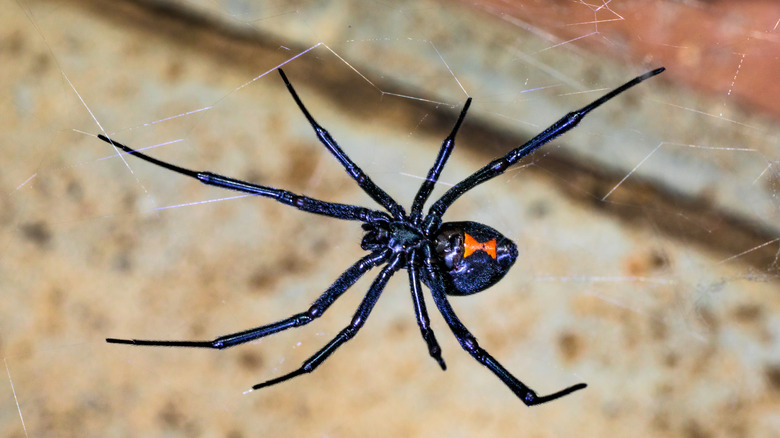What To Do If You Spot A Black Widow Spider In Your Home
You move a few boxes in your closet, only to have a scare from one of the most feared arachnids: the black widow (Latrodectus). While your first instinct may be to scream like you're in a horror film, remain calm. These spiders are shy but do attack if threatened, so avoid sudden movements. A big mistake you don't want to make with black widow spiders is trying to squish them, or you risk a bite. They contain a neurotoxic venom, with symptom onset a few hours later, resulting in reactions such as cramping, fevers, chills, and nausea. Although they can be painful, black widow bites rarely end in a fatality. If you see one, capture and release is the best removal method.
A variety of widow spiders live in the United States, including the southern black widow (Latrodectus mactans), the northern black widow (Latrodectus variolus) and the western black widow (Latrodectus hesperus). They're known for their tangled, messy webs and distinct hourglass-shaped marking on the underside of their abdomens. The females feature a shiny black body with a red hourglass, and are what most people think of imagining a black widow. All black widow spider bites are by females, as the males have smaller fangs. Smaller in size, males also feature brown and gray coloring with occasionally the same hourglass mark in yellow or white. Sometimes they may also have stripes or spots. Spotting male black widows is very rare, and chances are, you will encounter a female. If and when you do, knowing what to do can help you avoid their bite.
How to handle a black widow spider sighting in your house
Black widows are often encountered outside, as they prefer woodpiles and other dark, secluded spots. They may make their way inside when carried in nestled among pieces of firewood or by crawling through small cracks. Spots in your home where you are most likely to find a black widow include closets, basements, planters, piles of clutter, and crawlspaces. If you spot a black widow spider, the first thing you should do is keep any children and pets away from the area. Widow bites can be especially dangerous for children under 16 and may require hospitalization to treat the symptoms. Once they're secure, you can either try to capture the arachnid or call a professional pest company to handle the situation. To catch the spider, wear a pair of gloves then place a cup or jar over it. When the spider is safely contained, slide a piece of paper underneath the cup to seal it off, then release it outside far from your home.
Pest control experts stress that if you see one black widow around, it's likely there are others in your home. It may also indicate you have a problem with insects, as these are the black widows' food source. You can vacuum any webs or egg sacs you see regularly, emptying the bag or container safely outside. You should also treat infestations of any insects they feed on to manage the problem. There are also essential oils to keep black widows out of your home. Try spraying your baseboards, closets, and corners with a mixture of peppermint oil and water.

